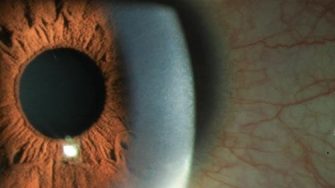Friday 17 February 2023
Rise of lasR mutant in Pseudomonas aeruginosa keratitis
Professor Robert Shanks (The University of Pittsburgh)
Professor Robert Shanks (The University of Pittsburgh)

Abstract: Pseudomonas aeruginosa is a Gram-negative bacteria that causes severe ocular infections and is a leading cause of contact lens associated keratitis. A prior study analyzing strains from India (SCUT study ranging from 2006-2010) observed that approximately 22% of isolates (n=101) had mutations in the lasR gene. This gene codes for a key regulator of quorum sensing and previous animal model studies suggest that this gene is important for keratitis. Furthermore, in the SCUT study, patients with the lasR mutant had worse clinical outcomes. Since this was a regional analysis, we tested our group of P. aeruginosa keratitis from the Northeastern United States collected from 1992-2021 (n=399) for lasR mutant phenotypes. We observed an increasing trend in the frequency of sheen positive isolates, with 0% from 1993-1997 (n=57), 11% from isolates from 1998-2002 (n=63), 15% from 2003-2007, 16% from 2008-2012, 26% from isolates between 2013-2017 (n=101), and 26% for isolates between 2018-2021 (n=61). The majority of tested sheen positive isolates had mutations in the lasR open reading frame when tested by sequencing. These were generally loss of function mutations, although one was a dominant negative mutation. We characterized the clinical isolates with intact and mutant lasR genes and generated deletion alleles in defined strains. These were tested in rabbit intrastromal injection models of keratitis and in ocular surface survival models. In addition, the patient outcomes were compared for lasR versus wild-type isolates from our hosptial and found to be similar with favorable outcomes for the lasR mutant infected group. The differential results between the India and USA outcomes and prior animal model studies will be discussed. In conclusion, the frequency of lasR mutant P. aeruginosa is increasing among keratitis isolates in our study. However, our study raises controversy regarding the clinical outcomes.
Bio: Robert Shanks earned a B. A. in Biology from Alfred University with studies on the mutagenic properties of herbicides. He earned a Ph.D. in Microbiology and Molecular Biology at Tufts Medical School in Boston working in the laboratory of Dean Dawson on chromosome segregation, DNA recombination, and the role of motor proteins in meiosis of budding yeast. He did a post-doctoral fellowship at Dartmouth Medical School in the laboratory of George O'Toole on Staphylococcus aureus and Pseudomonas aeruginosa biofilm formation and was then hired by the Charles T. Campbell Ocular Microbiology Laboratory at University of Pittsburgh Department of Ophthalmology. Since then, he has established a laboratory that focuses on bacteria that cause ocular infections and his group uses molecular genetic approaches to define bacterial attachment and virulence factors. He has been an author on more than 100 peer reviewed papers and 3 patents, is a permanent member of the National Institutes of Health grant study section, and is a co-founder of a company that focuses on delivery of biologics to the ocular surface.
Friday 17 February 2023
12:30 - 1:30pm
Rupert Myers Theatre / Zoom
https://unsw.zoom.us/j/83023210928?pwd=c2tBL2lsdFJMQldaTjNiT09DRVhTQT09
Password: spinet